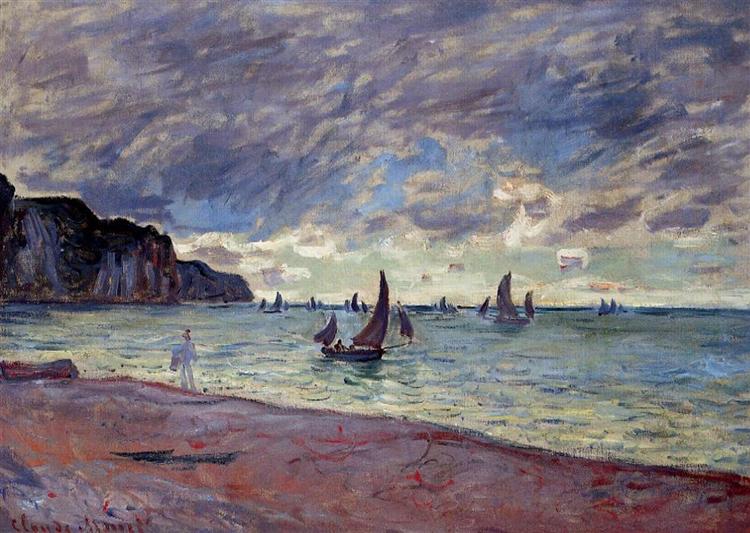תיאור
The painting "Fishing Boats by the Beach and the Cliffs of Pourville", painted by Claude Monet in 1882, is a representative work of the seascape that characterizes much of his artistic production. This painting captures the essence of light and movement in a scene that evokes both the serenity and energy of the coastal environment. The scene narrates, with delicacy and precision, the daily life of the Normandy coast, a place that Monet visited frequently and that became one of his favorite subjects.
At first glance, the composition is established through a balance between the fishing boats, the sand of the beach and the imposing cliffs that rise majestically in the background. The perspective is organized in such a way that it leads the viewer's gaze from the small boats anchored on the shore towards the high cliffs of grey and green tones, which are silhouetted against a partially cloudy sky. This visual hierarchy emphasizes not only the natural beauty of the landscape, but also the coexistence between human labor and the natural environment.
Color is one of the most fascinating aspects of this painting. Monet uses a vibrant and varied palette that captures both the luminosity of the day and the texture of the sand, sea, and clouds. The use of deep blues and greens for the water reflects the depth and dynamism of the ocean, while the soft lighter tones in the sand and sails of the boats suggest the sunlight shining on the scene. This color choice not only adds aesthetic beauty but also creates an almost sensorial effect, inviting the viewer to experience the atmosphere of the place.
The depiction of human activity is limited to the fishing boats, which flow in harmony with the landscape. The absence of human figures on the beach creates an atmosphere of tranquility, allowing the viewer to focus their attention on the natural surroundings and the symphony of colors. This focus on the everyday and the ephemeral is a characteristic feature of Impressionism, an artistic movement of which Monet is one of its greatest exponents. In this work, as in many of his other paintings, he seeks to capture a fleeting moment, immortalizing the interaction between light and nature.
Monet painted “Fishing Boats by the Beach and the Cliffs of Pourville” during a period when he was moving away from the strict compositions of the past and beginning to explore a freer, looser style. This development is revealed in the application of the paint, where the brushstrokes are perceived as loose and rapid, a technique that allows the light to be the true protagonist of the work. As in other marine works, such as “Impression, Rising Sun,” Monet uses the sea not only as a subject, but as a medium to explore sensory and luminous perceptions that resonate with the viewer.
In the context of Impressionism, this work can also be seen as a testament to the artist’s experimentation with light and colour, elements that would make Monet a pioneer in the use of the “plein air” technique, which consists of painting outdoors, thus capturing the atmosphere and changing light of nature in real time. “Fishing Boats by the Beach and the Cliffs of Pourville” is therefore not only a visual record of a specific moment in time, but also a profound exploration of the relationship between man and his environment, in which landscape and light take on equally important roles.
With this work, Monet continues his legacy of interpreting nature, where beauty lies not only in the painted object, but in the profound experience it generates in the observer. The connection between man, the sea, and the earth becomes a permanent dance, a theme that continues to resonate strongly in contemporary art and invites a broader reflection on our own relationship with the natural world.
KUADROS ©, a famous painting on your wall.
Hand-made oil painting reproductions, with the quality of professional artists and the distinctive seal of KUADROS ©.
Painting reproduction service with satisfaction guarantee. If you are not completely satisfied with the replica of your painting, we will refund 100% of your money.

